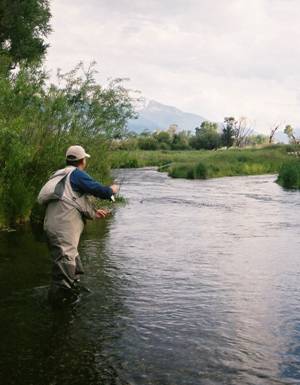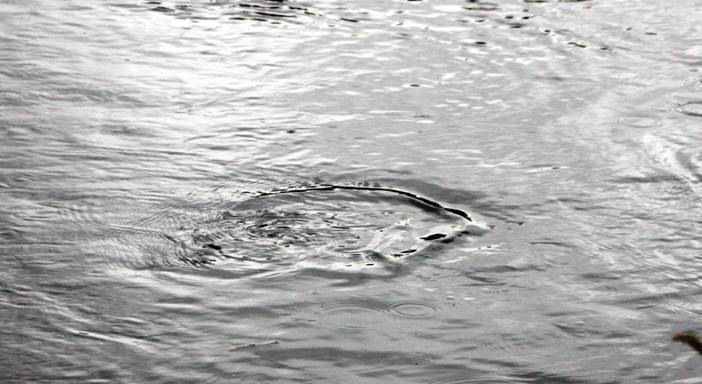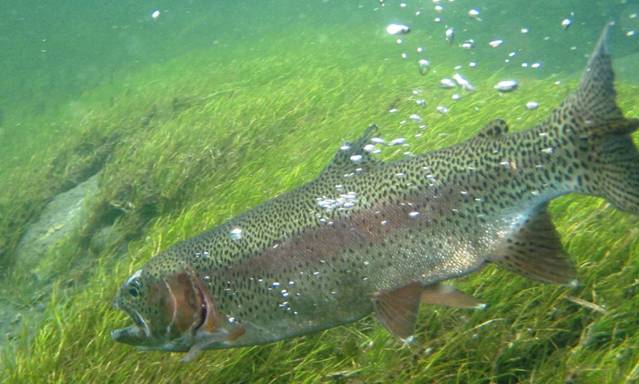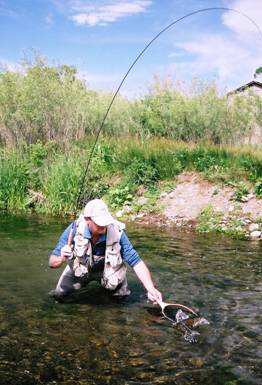EVENINGS ALONG THE STREAM (part 6)
| Sysadmin Note |
|---|
| Part Five can be found here |
June 27th, the morning was very slow, with very few trout showing before the hatch which didn't show up until 11 A.M. When the trout began to feed it was not with the classic movements that we often associate with nymphing trout. Instead of holding and feeding in one area they were moving around like drunken sailors. I had seen this behavior before and had figured out a game plan for this situation, therefore I will share the story which is; A FLY FISHING MYSTERY, The case of Nymphing to the Moving Trout. This is a situation when knowledge must be coupled with observation if the angler wishes to be successful.

To be a highly successful fly angler it is wise for the angler to have good casting skills, reasonable equipment for the task at hand, and a good working knowledge of the trout and the food forms they feed upon. Having a reasonable fly selection is desirable, though not as critical as some would have you believe, for many different patterns will work effectively if presented properly. I know many such anglers and have guided them all over the waters of Montana and Yellowstone National Park for years. In normal situations they can be deadly effective.
However, there is one area, one skill, which most have yet to master consistently, and that is the skill of observation and the patience to employ it. I once observed an angler who had visible feeding trout all around him, and would make a few casts to a trout, then frantically change flies and make a few more casts and change again. On this particular day I was not guiding. Rather, I was out fishing on my own and he had seen me hook several trout. He was fishing below me and was becoming more frantic by the minute. Finally I reeled in and waded to shore, traveling out and around so as not to spook his trout. I finally reached a position where I could quietly inquire if he would like a couple of tips.
He told me that he didn't understand, the trout were rising all around him and he had stopped at one of the local fly shops and was well supplied with an impressive selection that easily imitated the adult insects that were hatching. He told me that he had tried just about every dry fly type he had and had only risen one trout and by the time that happened, he was so nervous and frustrated that he had missed the fish, which only made matters worse.
I asked if I might enter the water and approach. Upon receiving an affirmative reply, I slid into the water and slowly and carefully approached his position. I pointed out a healthy rainbow trout that was greedily feeding away. The trout was slightly above and across from his position. He replied that, yes, he could see the feeding trout, and had cast to it several times with several different patterns and had been snubbed and ignored by this sassy rainbow.
I told him that is because you are not feeding him what he is eating. As you might guess, he exploded."Are these not Pale Morning Duns that are hatching?"
I replied in the affirmative.
"Well in that case I have thrown every adult PMD I have at them! So now what?"
I said, "Ok, let us stand here for a couple of minutes and watch that trout feed. Do you see the Duns on the water?"
"Yes."
"Do you see the trout eating any of the Duns that are floating right over him?"
"No."
"That is because he is feeding on the emerging nymphs that are just three to six inches beneath the surface film."

I told him to watch the rise and notice how the trout was not tipping up sipping off the surface but was steadily bulging where his back and dorsal fin were breaking the surface film. I could see the light go on.
With a few more tips and a half dozen emerging nymphs, I silently departed and soon he was into that nice Rainbow.

Soon I was back after my own fish, and lost track of my new angling friend. Much later in the afternoon after the hatch had faded and both the trout and the anglers were taking a break my angling friend once again approached me. First he wanted to thank me for the assist, and then to ask, "How did you know and understand what the trout were doing?"
I explained that I fished here often and was, in fact, a fly fishing guide who was taking a busman's holiday, so to speak. I often answer that particular question in that manner and I usually get the same response, "Oh, so you are a guide. That explains everything."
I replied that actually, it explained very little and that the key to solving his problem was Observation! I told him that rather than frantically fishing, his best approach would be to slow down and pay attention to where the trout was feeding the water column and if there were adult insects on the surface and if the trout taking them! He replied that he only got to fish water like this a few days a year and he hated to waste any time just standing around and watching. I gave him one my most favorite replies; It is not how many hours that you fish a day that is important, it is how many hours a day you fish effectively. I could see the light of reason and I knew that I had reached him. This was an easy lesson and I was happy to be of assistance.
Now, let us turn to a different situation where knowledge may hinder us unless it is coupled with observation. Much has been written about the feeding behavior of the various species of trout, and acquiring that knowledge will most definitely aid the angler in reading each angling situation encountered. How the trout feed and what the various rise forms mean has also been well documented in the chronicles of man. This kind of knowledge will also be of great value to an angler when solving the problems of a particular angling situation. As you will see, all of this knowledge is to no avail unless it is coupled with observation, an open mind, and a willingness to adapt to various situations as you encounter them.
Remember, the rules and general understanding of trout behavior has been written by man and the trout have no voice in those proceedings. Therefore, fly anglers operate on knowledge, experience and logic; whereas the trout operates on natural instinct! Often we as anglers lose the contest when dealing with the trout. Now let me tell the tale of the moving trout.
We were fishing the Pale Morning Dun hatch during the prime time of early July on Armstrong Spring Creek. The hatch had started around the 22nd of June and the hatches had been dependable and heavy. When dealing with a situation of this description the angler will find the trout beginning to feed on the migrating nymphs. At first the trout may move around a little bit, but as the emergence draws near the trout will find a hole in a feeding lie where it can feed and use as little energy as possible. Therefore, if you can see the rise form, even if you cannot actually see the trout, you should be able to effectively cover that fish and, everything else being equal, hook the feeding trout.
We had been fishing on Armstrong's for two days and had three more spring creek days planned on Nelson's and DePuy's. For the past two days the trout had been following the script and the pre-hatch nymphing had been excellent. We would start out fishing the nymphs near the bottom and slowly move them up in the water column as the naturals moved up in the water column. That was until today. We had worked several trout casting up and across stream to them and we also positioned ourselves at the base of riffles and worked several trout that were above us. Yet we were not enjoying the same amount of success that we had over the previous two days.
What was different today? It was not what they were eating, as we had taken a couple of trout and the stomach pump sampling confirmed that they were indeed taking nymphs. We had tried different depths with presentation and we had tried some different angles. So what was different? We talked it over and I said we needed to carefully move up on these trout and change our angles so that we can actually see how the trout were feeding. We eased our way to the bank, carefully moving up, step by step, so as not to disturb the feeding trout. Finally, we were in position and what we witnessed was surprising.
Remember, this was a heavy emergence. But we watched that trout move from side to side, and back and forth over a thirty foot area. Now by all accounts that trout should have been in a strong feeding lie allowing the current to bring the food to it. Furthermore, this was not a one-trout feeding anomaly. Over seventy percent of the trout that we could clearly see were feeding in the same manner.
Yes, I have seen trout perform this abnormal feeding behavior at other times, but never under conditions where the hatches have been steady, dependable and heavy over a period of time. Normally this type of behavior is exhibited early in hatch cycles or when hatches are lite in (insect) numbers.
I have also witnessed this nomad type of feeding behavior by individual trout as hatches begin to fade. But never have I seen this type of behavior during a heavy emergence and by so many trout, and neither had my fishing friends.
 Once we could see the trout, we understood that we had to approach these feeding fish in such a manner that we could observe what they were doing and when they were doing it. In most cases that meant getting across from the trout and observing the feeding pattern. Even though they were traveling greater distances than was normal, you could still see a pattern of movement. Thus, we were able to figure out where the trout was going to be and then present the imitation in the proper manner. This did, however, make for some interesting casting strokes, which caused us all to laugh. At times it was like watching Mimes trying to fish. I hope that the mental picture of that brings a chuckle to your lips, it sure had us laughing.
Once we could see the trout, we understood that we had to approach these feeding fish in such a manner that we could observe what they were doing and when they were doing it. In most cases that meant getting across from the trout and observing the feeding pattern. Even though they were traveling greater distances than was normal, you could still see a pattern of movement. Thus, we were able to figure out where the trout was going to be and then present the imitation in the proper manner. This did, however, make for some interesting casting strokes, which caused us all to laugh. At times it was like watching Mimes trying to fish. I hope that the mental picture of that brings a chuckle to your lips, it sure had us laughing.
In some cases, we were able to position ourselves slightly below the feeding trout. However, for the most part, we were straight across from the trout and sometimes even slightly above the trout. But the key to solving the problem was being able to see the trout and see the feeding. Without this we would have been fishing blind. The end result was that we were once again taking trout in a consistent manner.
Now, I will caution you, when approaching trout is manner, where you are visible to the trout, wade slowly and with caution. Those who wade like they are walking down the street will spook the trout.
You might think so what; you solved an anomaly that is seldom seen. Well I am glad we solved the problem, because I witnessed this behavior all the rest of the summer on all three of the spring creeks. Not every day, but often enough to make us grateful for the solution. I spent the rest of the summer sharing this information with many anglers. This isn't something you just see on the spring creeks. I have observed this behavior on the Big Horn River, the Missouri River below Holter Dam and on the Henry's Fork.
Why do the trout go off script, so to speak, and act in this manner when their whole survival and growth depends on calories spent versus calories ingested? This I do not know. I have theories, but nothing I am willing to expound on at this point. I do however, know this-- that the biology and actions of trout are not only more complicated than we know, they are more complex than we can know.
I also know that knowledge alone will not solve all of your angling problems on the water; you still need to be observant. Go fishing, laugh and enjoy your time on the water.
Enjoy & Good Fishin'
| Sysadmin Note |
|---|
| Part Seven can be found here |
